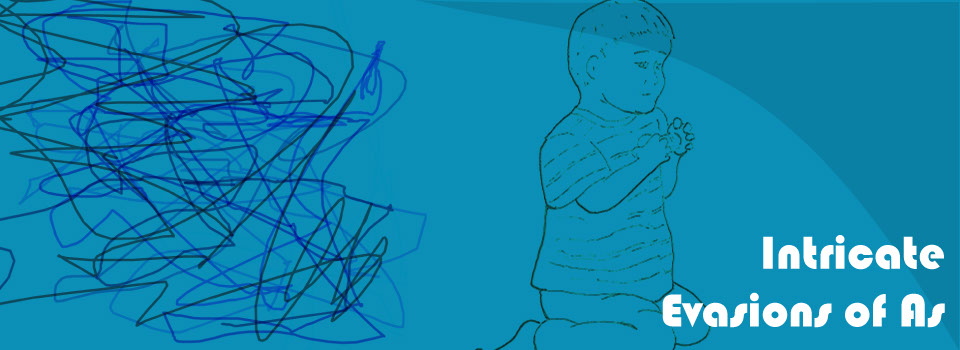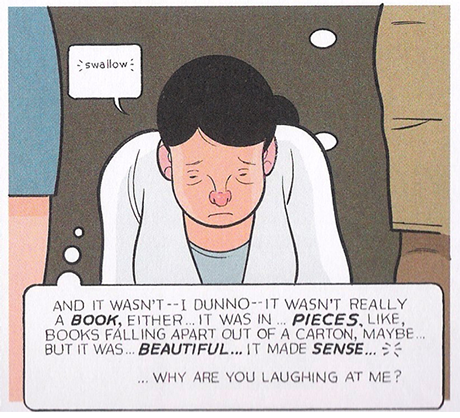
x
Contents
Home
Home
Home

In his 2006 Economics of Attention: Style and Substance in the Age of Information, Richard Lanham outlines a theory of “revisionist thinking,” or what he calls a sixth canon: oscillatio. When we are faced with a medium, we can either look through it, seeing the content, or at it, seeing how that content is constructed materially. To be a rhetorician, it would seem, would be to concern ourselves with these surface issues. Here Lanham’s distinction between Homo rhetoricus and Homo seriosus feels relevant. To link the two binaries, we might say that the serious person can only look through the medium to the content, neglecting the ways the form bends that content. The rhetorical person only looks at the medium, sees only the bending—the content is irrelevant.
We can see these two operations happening in any rhetorical artifact, but let’s look more closely at an example from Building Stories to see how this works in comics. In this detail from the page analyzed elsewhere, the protagonist is relating a dream in which she’s discovered that all of her secret writings and drawings have been published. It’s a complex panel, and in some ways the key to the entire book.
Looking through, we see a kneeling woman looking downward, flanked by two unnamed people. She looks sad. This is a split moment between the dream and her telling of it, and the sadness of the telling has infected the dream itself. The word balloon portrays sound from the dream, and the thought balloon relates her retelling.
Looking at, we see the sizes of the words themselves. The word balloon’s “swallow” is tiny, oddly placed, and flanked by emminata. The thought balloon’s letters are larger and seem more regularly spaced. They too include emminata, although this time it expresses a cutting off of discourse: visual aposiopesis. Throughout the panel the lines are drawn in a variety of weights and styles. The balloons’ lines are thick and regular, seemingly drawn with a straightedge of some kind. The circles of the thought balloon are similarly regular. But the lines of the people show less discipline. Ware’s style has often been seen as almost architectural in its clean lines and simplicity. However, when we look more closely, we see some of the lines misbehaving. In the upper-right corner a person’s outline has bled onto the white panel border, as has the skirt or shorts outline on the left side. Throughout the people there are a variety of thinner lines: a stray hair, the back of a knee, bags under eyes. The thin line of the protagonist’s mouth gains in emotional weight what it loses in physical weight.
Of course, just as the engineer is a myth created by the bricoleur, so too we have to look at before we can look through. We need to see the lines, colors, shapes, to build a coherent story. It’s just that most of the time we do this unconsciously.
Meaning exists in oscillation between these two modes. When we combine our readings of the panel, we can actually see the entire argument of the book (according to Kashtan’s reading) in this single panel. The organic lines of the people are confronted with the artificial lines of the words. Similarly, the materiality of the book is confronted by the immateriality of e-books. Ware’s argument is not that we need to reject the digital but that we need to bring it into play with the analog. The synthesis need not be final, either, but can be done hesitatingly, so that we are left with “pieces. Like, books falling apart out of a carton, maybe” (Building Stories). It can be beautiful. It can even make sense. But only when combined.
Lanham informs us that to live in either world is impoverishing, and a proper education teaches both looking through and looking at: “‘Revisionist thinking’ . . . has always lain at the heart of rhetorical education and practice, and the tool that makes it possible is the toggle switch I have called oscillatio” (254). Oscillatio means switching back and forth between looking through and looking at. Lanham calls the ability to maintain these two contradictory views at once “bi-stable” oscillation. If this oscillation seems impossibly chaotic, we should focus on the matter of stability, a metastability* to use Gilbert Simondon’s term. Each of the various elements in a metastable milieu are dynamic, but the milieu itself responds appropriately to maintain stability.
This bi-stable oscillation comes into play when we revise. When Lanham refers to revision, he means it quite literally:
We think words ought to come to us as naturally as breathing, without artifice. And, we also think, they should be understood in the same way. They should be transparent and unselfconscious. Revising word, image, or sound violates these unconscious assumptions. To look at the expressive surface, reflect on how we have communicated what we wish to, puts pressure on what we have said. We look at it as a stranger might, or try to. We think about what we have said with a different side of the brain. We will then see, especially if we have been trained in revision, where and how we have failed to “say what we wanted to say.” This involves more work, and more drafts. We put pressure, in this way, on our own thinking. And we also become more comfortable with the bi-stable way of examining an expressive surface, through for meaning, and at for style. (256)
It’s no mistake that Lanham refers to this urge toward clarity as unconscious. However, in connecting much of this to Lyotard, we need to be clear about how conscious this really is. In Freudian terms, it is not the id but the superego that fights for coherence.
In Lyotard’s terminology, the figural fights against discourse’s claims at clarity. This fighting against is at the behest of the death drive. This allows Lyotard to maintain a monism (the figural is what creates discourse), dualism (the death drive uses the figural to maintain the binary of figure, discourse), and pluralism (the figural cannot be satisfied by a single dualism; it always pushes out to another and another space) all at once.
Lanham indicates that digital technologies encourage the bi-stable oscillation of revisionist thinking. While he carefully avoids embracing anything that might be seen as a clear technological determinism, he also recognizes that different technologies have different advantages and disadvantages: “Any technology that makes this oscillation easier, that sharpens this tool, lubricates human invention and expression” (256). It is not which tool that matters, but the awareness of our tools.
Among Lanham’s various examples we find animated Flash résumés alongside Duchamp’s ready-mades and a 1932 font advertisement. The common denominator across all of his illustrations is not just attention but attention to materiality. Economics of Attention feels very reader-focused at times. Eyeballs are the new currency, as Lanham constantly reminds us. On the other hand, the book ends with a call to revisionist thinking, moving the thrust of the argument from reader to author or author as reader. Yet through it all, the unspoken emphasis is on materiality and its sensuous depth.
Lanham’s key binary for the book is the stuff/fluff dichotomy. Stuff signifies content, fluff form. In a sense, Lanham’s book offers a deconstruction of this binary, siding neither with stuff nor fluff but finding answers in oscillation. This is why he must be so careful to distinguish his position from anything too scary or postmodern:
The temptation to shut down the oscillation, to stifle the creative breath of the western world, has been strong from the beginning. Surely, in all these contrasts, top-down versus bottom-up control, the social self versus the central self, the philosopher versus the rhetorician, substance versus style—or, as I have styled it, stuff and fluff—one has to be right and the other wrong. The history of thought is composed of such antithetical arguments. Yet the way through the perils has always lain not in compromising or mixing the opposites but in holding them both in mind in delicate alternation. Revisionist thinking is not relativist thinking. It provides an opposite method, a way to hold absolute truths in mind without compromising them or imposing them on other people. (260)
Revisionist thinking provides Lanham a way out of the culture wars of the last decade of the twentieth century and creates a rhetoric for the first decade of the twenty-first.
I have focused on Lanham for his clarity on the topic. I hear the conflict there, given Lanham’s well-known eschewal of the myth of clarity, but Lanham is clear—he just doesn’t think that’s the only way to write. That still might be a problem though. To write with that level of clarity would seem to push readers away from the kind of oscillation he has recommended for us. I worry about that for myself as well. Perhaps I am being too clear (yes, I can hear you protesting). It’s a careful negotiation, but one we must each attempt.
Lest we move too quickly, though, let us linger on the strangeness of his terms. Lanham’s stuff is ethereal, abstract, the real meaning behind the things we see around us. His fluff is material, physical constraints and opportunities. But fluff creates stuff. And once we consider that, the terms don’t seem all that useful. Stuff shouldn’t be ethereal. It should be stuff, real things that can really change and affect the world. We should never call that stuff “fluff.”
If you would like to investigate this stuff / fluff dichotomy, turn to page 73.
If you would like to skip ahead to the things themselves, turn to page 54.
If you would like to turn down the prince’s kind offer and fight the dragon yourself, turn to page 5,438.

only according to “stuff”

revision is transgressive
Detail from Building Stories. Click to enlarge.
philosophy and rhetoric
stuff and fluff
thought and speech
idea and material
For a further discussion of Lanham's terms and their relationship with Heidegger, see Vorhandenheit.

*Casey Boyle has made this connection as well in his recent Computers and Composition article, "The Rhetorical Question Concerning Glitch." Boyle's argument resonates with my own.

